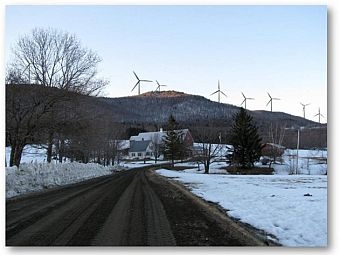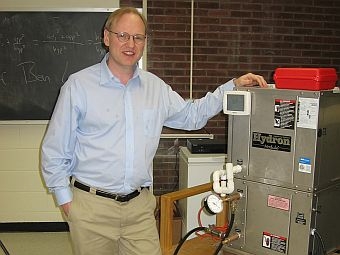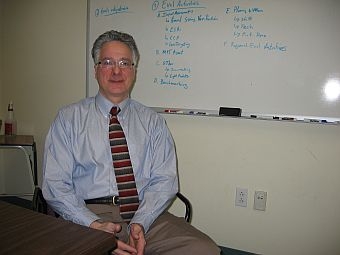
(Host) Supporters and opponents of commercial-scale wind energy projects on Vermont’s ridgelines use a lot of statistics and facts to argue their very different sides of the debate.
So it’s difficult to sort out how much carbon pollution might be cut if there were big wind turbines in the mountains. Or whether the wind generators could replace bigger electric plants, such as Vermont Yankee.
As part of a series on the future of wind energy in Vermont, VPR’s John Dillon explains the complexities.
(Dillon) Leading environmental groups say Vermont has a "moral obligation" to combat climate change. And they say developing wind projects on the state’s ridgelines is the way to make progress.
Brian Shupe of the Vermont Natural Resources Council says all that’s needed is some planning.
(Shupe) "The lack of a coherent energy plan in the state has not allowed Vermont to adequately prepare for the closing of Vermont Yankee, or to address climate change in a meaningful way."
(Dillon) Those are the twin goals of many Vermont environmentalists: Shut down Yankee and reduce greenhouse gas emissions.
But can industrial-scale wind do the job? Can it replace Yankee? To answer that, we need to step back for a moment for a lesson on how the electricity grid works.
Yankee is what’s known as a "baseload" plant. That means – barring an unexpected shutdown – it cranks 620 megawatts into the New England grid all day, every day, all year.
But the wind doesn’t blow every day, so wind power can’t be baseload. It’s known as intermittent.
ISO New England, which oversees the regional energy market, says more wind will not replace nuclear reactors like Yankee, or the big greenhouse gas polluters -coal-fired plants.
 (Luce) "I’m Ben Luce. I’m a professor at Lyndon State College."
(Luce) "I’m Ben Luce. I’m a professor at Lyndon State College."
(Dillon) Now, let’s pause for a moment for a lesson in a science lab.
Professor Luce has sandy hair and round glasses. He speaks in the measured, analytical tones of a physics professor, which is what he is. In his lab, Luce tinkers with a shiny chrome device. It’s a heat pump, kind of a reverse refrigerator.
(Luce) "Well, we try to teach about the principals of clean energy technology so people really understand them. And this geothermal heat pump unit is one we’re evaluating."
(Dillon) Because he advocates for renewable energy, Luce has high hopes for devices like this. It can covert the cold temperatures from the ground into heat that can be used to warm buildings. But despite his environmentalist credentials, Luce is skeptical about wind in Vermont. He encouraged it in New Mexico when he worked there. But he says there’s just not enough wind potential here to make much of a difference in global climate change.
(Luce) "On the scale of U.S. energy usage, it’s quite small. If you were to develop all the so-called developable wind resources in the eastern United States they would only be able to reduce U.S. CO2 emissions by about 1 percent."
(Dillon) Notice he said if you were to develop all the wind resources. That means turbines on many, many ridgelines. Even if you did all that, says Luce, you wouldn’t make much of a dent in climate change.
(Luce) "It really is a minor resource. At the same time developing it in my opinion would have an incredibly adverse effect on the ecology and the economy and the character of the state."
 (Dillon) Yet Green Mountain Power says the 21 turbines the company hopes to build on Lowell Mountain will cut greenhouse gases. Robert Dostis is a company vice president.
(Dillon) Yet Green Mountain Power says the 21 turbines the company hopes to build on Lowell Mountain will cut greenhouse gases. Robert Dostis is a company vice president.
(Dostis) "Every kilowatt of electricity that’s produced from Lowell is power we don’t have to buy from some other resource. And if that other resource is a fossil fuel, then that’s carbon we’re not putting into the atmosphere."
(Dillon) But how much lesson carbon? GMP says it’s difficult to say because different fuels create different emissions.
(Dostis) "The bottom line is, any development of this size obviously is going to have impacts, and it’s about the trade-offs."
(Dillon) Even if environmental concerns weren’t part of the wind equation, there’s another piece of the energy system that critics say has to be considered.
It’s the question of "spinning reserve." Here’s what that is: A spare power source, ready to kick in whenever it’s needed. Think of spinning reserve like this. When you’re sitting in your car waiting at a stop light, you want to be able to go as soon as the light turns green. It’ll take longer to get rolling if you have to restart the engine after every stop.
The electricity system is much more vast than a single car, though. So it also needs another reserve, one that could be powered up within 10 minutes.
New England needs 1,200 megawatts of both kinds of reserve electricity on hand. It usually comes from baseload hydro, nuclear or fossil fuel. Experts say if wind were a more significant part of the mix, there would be an even greater need for reserve because wind is intermittent.
Despite wind’s limitations, environmental groups argue that Vermont has to do something to move away from nuclear and fossil fuels. James Moore of the Vermont Public Interest Research Group says five or six wind projects would make a significant impact.
(Moore) "We’re talking about 8 percent of the state’s annual electricity demand already being met by local resources just in the next couple of years."
(Dillon) But Physics professor Ben Luce has a different idea: solar. He says it’s getting cheaper and produces electricity when it’s most needed.
Luce says he wants the debate to be driven by science not hope.
(Luce) "So when people say we have to do something, my response to that is to say we really need to do something serious, not something that is just effectively symbolic."
(Dillon) Most of Vermont’s greenhouse gases come from vehicles and heating fuels. Luce says that’s where the state could focus.
For VPR News, I’m John Dillon in Montpelier.
(Host) Tomorrow our series concludes with a look at how wind projects are financed.